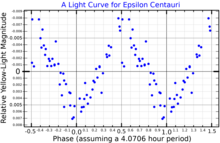| Observation data Epoch J2000 Equinox J2000 | |
|---|---|
| Constellation | Centaurus |
| Right ascension | 13h 39m 53.25774s[1] |
| Declination | −53° 27′ 59.0081″[1] |
| Apparent magnitude (V) | +2.30[2] (2.29 - 2.31[3]) |
| Characteristics | |
| Spectral type | B1 III[4] |
| U−B color index | −0.92[2] |
| B−V color index | −0.22[2] |
| Variable type | β Cep[3] |
| Astrometry | |
| Radial velocity (Rv) | +3.0[5] km/s |
| Proper motion (μ) | RA: −15.30[1] mas/yr Dec.: −11.72[1] mas/yr |
| Parallax (π) | 7.63 ± 0.48 mas[1] |
| Distance | 430 ± 30 ly (131 ± 8 pc) |
| Absolute magnitude (MV) | –3.9[6] |
| Details | |
| Mass | 11.60 ± 1.06[4] M☉ |
| Luminosity | 15,217[4] L☉ |
| Surface gravity (log g) | 3.68[6] cgs |
| Temperature | 24,000[4] K |
| Metallicity [Fe/H] | –0.14 ± 0.10[7] dex |
| Rotational velocity (v sin i) | 160[8] km/s |
| Age | 15.8 ± 5.7[9] Myr |
| Other designations | |
| Database references | |
| SIMBAD | data |
Epsilon Centauri (ε Cen, ε Centauri) is a star in the southern constellation of Centaurus. It is one of the brightest stars in the constellation with a slightly variable apparent visual magnitude of +2.30. Parallax measurements put it at a distance of around 430 light-years (130 parsecs) from Earth.
In Chinese, 南門 (Nán Mén), meaning Southern Gate, refers to an asterism consisting of ε Centauri and α Centauri.[10] Consequently, the Chinese name for ε Centauri itself is 南門一 (Nán Mén yī, English: the First Star of Southern Gate.)[11]

ε Centauri is a massive star with nearly 12 times the mass of the Sun.[4] The spectrum matches a stellar classification of B1 III,[4] indicating this is an evolved giant star. It is radiating more than 15,000[4] times the luminosity of the Sun from its outer atmosphere at an effective temperature of 24,000 K,[4] giving it the blue-white hue of a B-type star.[13] This is classified as a Beta Cephei type variable star with a primary period of 0.16961 days (4 hours 4 minutes), completing 5.9 cycles per day.[7] During each cycle, the brightness of the star varies from apparent magnitude +2.29 to +2.31.
This star is a proper motion member of the Lower Centaurus–Crux sub-group in the Scorpius–Centaurus OB association, the nearest such association of co-moving massive stars to the Sun.[6] Epsilon Centauri is a relatively young star, with an age of around 16 million years.[9]
The IAU has not assigned a proper name to this star.[14]
- ^ a b c d e Cite error: The named reference
aaa474_2_653was invoked but never defined (see the help page). - ^ a b c Cite error: The named reference
ducatiwas invoked but never defined (see the help page). - ^ a b Cite error: The named reference
gcvswas invoked but never defined (see the help page). - ^ a b c d e f g h Cite error: The named reference
an331_4_349was invoked but never defined (see the help page). - ^ Cite error: The named reference
rgcrvwas invoked but never defined (see the help page). - ^ a b c Cite error: The named reference
aaa216_1_44was invoked but never defined (see the help page). - ^ a b Cite error: The named reference
aaa433_3_1031was invoked but never defined (see the help page). - ^ Cite error: The named reference
mnras309_1_221was invoked but never defined (see the help page). - ^ a b Cite error: The named reference
mnras410_1_190was invoked but never defined (see the help page). - ^ Cite error: The named reference
zhwas invoked but never defined (see the help page). - ^ Cite error: The named reference
AEEAwas invoked but never defined (see the help page). - ^ Cite error: The named reference
Shobbrookwas invoked but never defined (see the help page). - ^ Cite error: The named reference
csirowas invoked but never defined (see the help page). - ^ Cite error: The named reference
iauwas invoked but never defined (see the help page).
